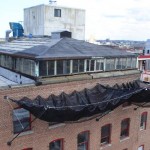Safety Netting – Best Practices To Protect Workers And People Below
 Does your facility feature elevated work areas, unstable walking or working spaces, unprotected edges, floor holes or wall openings?
Does your facility feature elevated work areas, unstable walking or working spaces, unprotected edges, floor holes or wall openings?
If so, there are safety-netting solutions to help ensure your workers – along with pedestrians and nearby structures – are safe from this large variety of fall hazards.
There are, however, places where it’s most important to make sure these solutions are in place:
Construction Sites
When there’s construction, there’s debris. That’s why it’s important to have one or more barriers in place (horizontal and vertical) prior to demolition or initial groundbreaking at a construction site.
A common solution is setting up a fine mesh barrier around construction sites on the ground level, which protects the streets, sidewalks and people around the construction site. This also provides a “visual” barrier of ongoing construction work from the public.
Debris nets may also be used around floors to contain wind-swept debris or dropped tools and certainly as a horizontal “envelope” around the perimeter of a building for fall protection and debris containment.
Open Pits
Open pits are often an overlooked fall hazard because it isn’t as obvious as an elevated surface or rooftop. Safety netting is a very good, cost-effective solution to fall protection for open-pit fall hazards.
An example of an open pit is an automotive maintenance bay. Mesh could be installed over the floor pit opening when not in use to catch and cradle a person falling into the floor opening.
Covering open pits in this manner is more beneficial than steel grating because it lets in more natural light for your technicians to see what they are working on.
Conveyor Belts
In today’s high-tech distribution centers, things move quickly and at a breakneck pace. With overhead conveyor belts, items sometimes become dislodged and fall. It’s important to protect the people working nearby or below these conveyor belts.
Safety netting is a great protector against falling packages and roller blowouts. The mesh provides a soft catch, greater visibility of the conveyor and helps ensure you are meeting all OSHA requirements for conveyor belt guards.
One scenario that’s gaining in market growth is the application of barrier systems during commercial roof replacement. For years, the commercial roofing industry struggled with ways to adequately protect their workers from falling through the deteriorated roofing they were replacing.
Installing a properly engineered safety-netting solution inside the building, utilizing the roof trusses, creates the horizontal barrier necessary to protect roofers. This barrier not only catches workers in the event of a fall, but also collects falling debris to protect everything below.
Best Practices For Safety Netting Solutions
The following are widely regarded best practices to attain the safest netting solutions for your facility.
Install High-Quality, Durable Safety Netting
Many facility managers try to save money by opting for cheaper, internationally-made safety netting as opposed to high-quality, American-fabricated nets. You need to ensure you’re using engineered and tested safety netting to provide effective fall protection for your workers. Two of the top US manufacturers – Incord and PearlWeave – have rigorous testing standards and high-quality manufacturing facilities.
Use Tested, Engineered And High-Quality Hardware
While usually the least expensive part to complete a safety netting solution, the hardware is crucial to the overall strength and integrity of the nets. If you don’t use proper hardware, the net system is at a risk for failure.
Implement Properly Engineered Layouts And Plans
Facility managers often feel it’s not necessary to engineer a safety netting system. This is a mistake. Engineering should be conducted to ensure the system will perform when needed, taking into account supporting structures and all forces that may be imposed on the system.
Ensure A Qualified Installation Technique
Make sure you have a competent third-party installer, or a supervised training session. While it might look simple, safety-netting systems are a bear to install. You don’t want to have an accident or something falling from 10 stories up because a worker was fumbling about with how to install the system correctly.
Ready to learn more about the best safety netting solutions for your facility? Call us at 800-452-0222.

